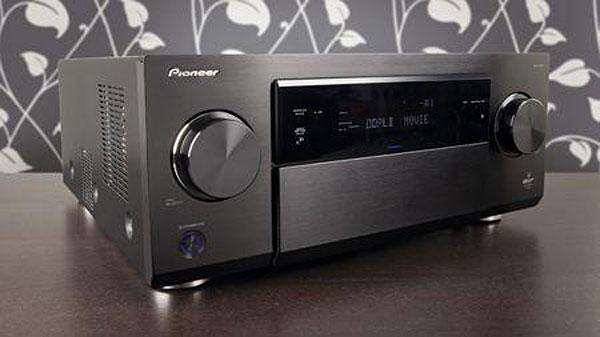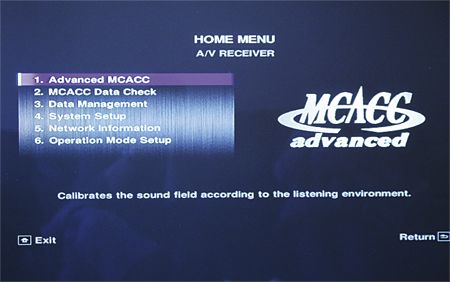Pioneer SC-LX87 review

 Pioneer’s range of AV receivers caters to budgets from the extremely frugal to the decidedly lavish. If you feel that you sit in the latter category, you will need to look at the top of the pile and the SC-LX87. And, although this flagship might not be as pricey as some of the company's previous one-box offerings (such as the SC-LX90), it's still a very serious amplifier indeed.
Pioneer’s range of AV receivers caters to budgets from the extremely frugal to the decidedly lavish. If you feel that you sit in the latter category, you will need to look at the top of the pile and the SC-LX87. And, although this flagship might not be as pricey as some of the company's previous one-box offerings (such as the SC-LX90), it's still a very serious amplifier indeed.
The basic specs only really tell half the story. The THX Ultra2-certified Pioneer packs nine channels of Class D amplification into the substantial chassis. Each is rated at 220W (albeit at a slightly benign six ohm measurement); most speakers are unlikely to prove a problem for it. The use of Class D amps (here known as Direct Energy HD) isn’t merely a convenience feature either, as Pioneer opts for these energy-efficient compact power plants in products where there is no need to save any room. And in keeping with Pioneer AV receivers of recent years, the SC-LX87 has been tuned by AIR Studios in London to further try and improve performance.
As you might expect, the connectivity available to you to make use of this amplification is epic. Nine HDMI inputs are on offer, which can in turn serve three outputs (one to a second zone). Additionally, the Pioneer supports a legacy set of component and composite video connections. These can naturally be transcoded to HDMI; 4K upscaling is provided in addition to ‘normal’ hi-def resolutions. Audio Return Channel and standby passthrough are also supported.

The audio side of the Pioneer is equally ambitious. There are several assignable digital and analogue audio connections that should allow hookup to almost anything you could expect to be sat on a rack near the AVR – you even get a moving magnet phono stage, which is a nice touch, although I suspect the number of turntables any given SC-LX87 will see can be counted on the fingers of one knee. Audio processing is handled by an ESS Sabre32 Ultra DAC, allowing for all audio to be upsampled to 32-bit/192kHz. Indeed, this resolution can be handled natively – files can be streamed from a computer directly to the SC-LX87 via USB, and Pioneer supplies an ASIO driver to aid this. Another useful sonic treat is Spotify Connect, should you be a fan of the music streaming service.
The Pioneer is also network-capable via Ethernet or a supplied LAN adapter and here things aren’t quite so slick. The provided setup information for the LAN adapter is lengthy but somewhat baffling and I eventually simply ran a long Ethernet cable to my router instead. Pioneer has since furnished me with instructions that make the process slightly easier, but it is still some way from being plug-n-play.
This operational challenge is a shame because once you do get the SC-LX87 up and running on a network the streaming options are useful and you can make use of the superior iControlAV2013 app to drive the receiver. Certainly, this app is preferable to the bundled remote control. This is a cluttered mess of tiny buttons that offers a choice of ‘basic’ functions, which turns too many useful features off, or ‘Expert’, which makes it far too easy to switch to Zone B and C – pretty pointless if you aren’t using them. Less tech-savvy family members will hate it, although it does, however, match well with the onscreen menus that are equally small and intermittently illogical.
The remote is pretty much the only bum note in what is otherwise a very nice piece of industrial design. The Pioneer looks imposing without being a leviathan, thanks to clean lines and a small number of visible controls. Blue LEDs and chrome detailing help to break up the unrelenting blackness. The only minor annoyance is that one of the protective plugs in the terminals refused to come out; I had to use bare wire connections on that speaker.
After running Pioneer’s excellent MCACC auto setup, which gave accurate distance, crossover and EQ settings for my Mordaunt Short Mezzos and Tannoy sub, the AVR showed some very likeable attributes from the outset. The Class D amplification imparts a character to the performance that I have heard in some of Pioneer’s stereo amps. There is a richness to its presentation that means the SC-LX87 never sounds forward or harsh but instead manages to be big, controlled and full-bodied even when driven with ferocity. Integration between speakers and sub is seamless.

This means that the Pioneer’s rendition of Fast & Furious 6 is a fantastic combination of bombast and accuracy. The chase sequence with the tank – as magnificently silly a scene as any – is hugely powerful but packed with detail and a real sense of the relationship of objects to one another. Yet the stand-out skill of the Pioneer is perhaps its ability with voices. Even when all hell is breaking loose on screen, the SC-LX87 keeps dialogue crystal-clear and perfectly placed. In terms of clarity and coherence, this is a seriously accomplished receiver.
As the numbers suggest, there is no shortage of power here, and because of the smoothness and clarity the SC-LX87 possesses you can create truly vast soundscapes without strain. The vastness of Star Trek Into Darkness is bread and butter to the Japanese amp but it is just as at home with the claustrophobic forests of Troll Hunter – in both cases the soundfield is completely convincing. This same smoothness and control makes the Pioneer a refined performer in stereo mode, although what keeps explosions under control in films can make the SC-LX87 sound ever so slightly safe with music.
Conventional broadcast material is also well handled and the unflappable nature of the Pioneer means that there is very little you can find, even at the wackier end of the TV guide, that will upset it. With very warm-sounding speakers it is possible that the SC-LX87 might come across as a little dull, but with anything that is remotely neutral, you should find this an AVR that you can kick back with for long periods without it ever sounding fatiguing. Of course, if you do get bored, you can spend some time tinkering with EQ settings on the fly with the app – although while fun I struggled to really improve things.
There is a great deal to like about the SC-LX87 as an AVR. It is a powerful, refined and detailed performer that is as happy with full-bore action as it is with art house intimacy. The feature set is also extremely good and there is no doubting its technical ability. The complex network setup, clunky interface and fiddly remote do take some of the sheen off, though. Sonically, the Pioneer is too good to ignore but it might cause you a few frustrations getting there. Still, many of the best things in life require you to work for them, eh?
Specification
Dolby TrueHD: Yes. And Pro-Logic IIz
DTS-HD Master Audio: Yes. And Neo:X
THX: Yes. Ultra2
Multichannel input: Yes
Multichannel output (claimed): 9 x 220W (six ohms)
Multiroom: Yes. Up to three zones
AV inputs: 4 x composite; 4 x digital audio (2 x optical and 2 x coaxial)
HDMI: 9 x inputs; 3 x outputs
Video upscaling: Yes. To 4K
Component video: 3 x inputs
Dimensions: 435(w) x 441(d) 185(h)mm
Weight: 18.1kg
Also featuring: Ethernet; Wi-Fi via supplied adaptor; 1 x USB for file playback; 1 x Type B USB-DAC input; MCACC auto calibration; iOS/Android control app; internet radio; vTuner; Windows 8 certified; DLNA networking; Spotify; ESS Sabre32 Ultra DAC; 32-bit/192kHz support; Audio Return Channel; standby passthrough; 4K passthrough; MP3, WAV, FLAC, AAC, WMA, AIFF, Apple Lossless, DSD compatibility; Direct Energy HD amplifier; Bluetooth via adaptor; RS-232; 11.2-channel pre-out; AirPlay; AM/FM tuner; PQLS; Advanced Sound Retriever
 |
Home Cinema Choice #351 is on sale now, featuring: Samsung S95D flagship OLED TV; Ascendo loudspeakers; Pioneer VSA-LX805 AV receiver; UST projector roundup; 2024’s summer movies; Conan 4K; and more
|






















































